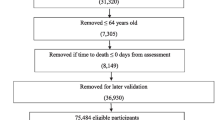Abstract
Traumatic orthopedic fractures in the elderly population can cause significant morbidity and mortality. The most common mechanism of injury for elderly patients with orthopedic fracture is a fall from standing. According to the Centers for Disease Control and Prevention (CDC), one out of five falls results in serious injury including fracture or traumatic brain injury. In the elderly population, over 250,000 patients are hospitalized each year because of hip fractures (Centers for Disease Control and Prevention. 2015. Important facts about falls. http://www.cdc.gov/homeandrecreationalsafety/falls/adultfalls.html. Accessed 9 Apr 2016; Centers for Disease Control and Prevention. 2015. Costs of falls among older adults. http://www.cdc.gov/homeandrecreationalsafety/falls/fallcost.html. Accessed 9 Apr 2016; Centers for Disease Control and Prevention. 2015. Stopping elderly accidents, deaths and injuries. http://www.cdc.gov/steadi/materials.html. Accessed 9 Apr 2016). In 2013, direct medical cost for treatment of hip fractures was approximately $34 billion dollars (Centers for Disease Control and Prevention. 2015. Important facts about falls. http://www.cdc.gov/homeandrecreationalsafety/falls/adultfalls.html. Accessed 9 Apr 2016; Centers for Disease Control and Prevention. 2015. Costs of falls among older adults. http://www.cdc.gov/homeandrecreationalsafety/falls/fallcost.html. Accessed 9 Apr 2016; Centers for Disease Control and Prevention. 2015. Stopping elderly accidents, deaths and injuries. http://www.cdc.gov/steadi/materials.html. Accessed 9 Apr 2016). In this injured population, it is important to provide evidence-based, expedited care to decrease complications and lengthy hospital stays which can ultimately cause severe functional decline and possibly death. Nursing measures to decrease the incidence of complications and shorten hospital length of stay should be implemented in all geriatric trauma fractures, whether operative or nonoperative.
Similar content being viewed by others
References
Shiga T, Wajima Z, Ohe Y. Is operative delay associated with increase mortality of hip fracture patients? Systematic review, meta-analysis, and meta-regression. Can J Anesth. 2008;55(3):146–54. https://doi.org/10.1007/BF03016088.
Chow WC, Ko CY, Rosenthal RA, Esnaola NF. American College of Surgeons NSQIP/ American Geriatrics Society best practice Guidelines: Optimal Preoperative Assessment of the Geriatric Surgical Patient. American College of Surgeons. 2009; 1–52. Retrieved from. https://www.facs.org/~/media/files/quality%20programs/nsqip/acsnsqipagsgeriatric2012guidelines.ashx.
Salottolo KM, et al. A retrospective analysis of geriatric trauma patients: venous lactate is a better predictor of mortality than traditional vital signs. Scand J Trauma Resusc Emerg Med. 2013;14(21):7. https://doi.org/10.1186/1757-7241-32-7.
Callaway DW, et al. Serum lactate and base deficit as predictors of mortality in normotensive elderly blunt trauma patients. J Trauma. 2009;66:1040–4.
Chow WB, Ko CY, Rosenthal RA, Esnaola NF. Optimal preoperative assessment of the geriatric surgical patient: a best practice guideline from the American college of surgeons national surgical quality improvement program and the American Geriatrics Society. J Am Coll Surg. 2012;215(4):453–66.
American Academy of Orthopedic Surgeons. Management of hip fractures in the elderly: evidence-based clinical practice guidelines. 2014.
Juliebo V, Bjoro K, Krogseth M, et al. Risk factors for preoperative and postoperative delirium in elderly patients with hip fracture. J Am Geriatr Soc. 2009;57(8):1354–61. https://doi.org/10.1111/j.1532-5415.2009.02377.x.
Kratz T, Heinrich M, Schlaub E, Diefenbacher A. Preventing postoperative delirium. Dtsch Arztebl Int. 2015;112(17):289–96. https://doi.org/10.3238/arztebl.2015.0289.
Vellas B, Wayne S, Romero L, et al. Fear of falling and restriction of mobility in elderly falls. Age and Aging. 1997;26:189–93.
Author information
Authors and Affiliations
Corresponding author
Editor information
Editors and Affiliations
Rights and permissions
Copyright information
© 2018 Springer International Publishing AG, part of Springer Nature
About this chapter
Cite this chapter
Price, E.L., Gandhi, R.R., Duane, T.M. (2018). Nursing Considerations for Traumatic Geriatric Orthopedic Injuries. In: Rodriguez, A., Barraco, R., Ivatury, R. (eds) Geriatric Trauma and Acute Care Surgery . Springer, Cham. https://doi.org/10.1007/978-3-319-57403-5_49
Download citation
DOI: https://doi.org/10.1007/978-3-319-57403-5_49
Published:
Publisher Name: Springer, Cham
Print ISBN: 978-3-319-57402-8
Online ISBN: 978-3-319-57403-5
eBook Packages: MedicineMedicine (R0)




